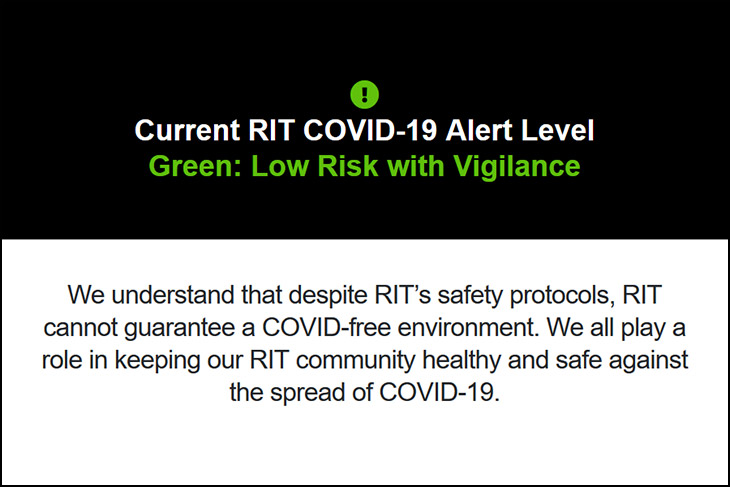COVID-19 alert system aims to identify, reduce risk
RIT is developing an alert system that systematically defines levels of COVID-19 prevalence and transmission risk within our community. Each level will be associated with predetermined actions aimed at reducing risk during the coronavirus pandemic.
The color-coded system enables the university to respond quickly to changing campus and regional health conditions. This design supports early recognition of a potential disease spread and gives RIT the opportunity to swiftly enact mitigation efforts. The alert levels are:
- Green is low risk with vigilance: Underlying threat of outbreak remains, but virus prevalence is low;
- Yellow is low to moderate risk: Prevalence of virus is low, but indicators show potential for increase in transmission;
- Orange is moderate risk: Prevalence has increased above baseline and indicators show rates of infection increasing; and
- Red is high risk: Spike in prevalence, strained capacity of campus and community support system.
“We will be monitoring the indicators on a daily basis and updating the alert system as the indicators suggest we need to,” said Enid Cardinal, senior advisor to the President for Strategic Planning and Sustainability, who assisted in drafting RIT Ready: Fall Reopening Plan. “This will enable RIT to respond quickly to rapidly evolving health conditions.”
The four risk levels are outlined in the RIT Ready: Fall 2020 Reopening Plan. The alert system details mitigation strategies appropriate to each risk level and includes efforts targeted at enhancement of education, behavioral expectations (wearing face masks, washing hands, and physical distancing), gathering size restrictions, limiting face-to-face activities, and up to transitioning to exclusive online instruction.
The alert system reflects Monroe County and New York state metrics of positive cases and hospital capacity combined with information generated across the RIT community through COVID-19 testing for cause, randomized surveillance testing, wastewater sampling, and Daily Health Screen (symptom monitoring) compliance.
Dr. Wendy Gelbard, RIT associate vice president for Wellness, and Dr. Lindsay Phillips, RIT medical director of the Student Health Center, will monitor indicators daily and analyze multi-day trends. They will advise RIT President David Munson on strategies and alert levels and potential response strategies.
“All this information will be entered into a dashboard and we will monitor the current state of campus affairs,” Gelbard said. “This will help us to determine whichever level we are at, and the information will help us determine if we need to alter any of our mitigation efforts.”
RIT expects every individual to protect themselves and the community by following new social norms outlined in the Reopening Plan and the RIT Safety Plan. The alert system will reflect the result of those efforts and prompt the community to act if indicators show a rise in COVID-19 on campus. The alert levels tell the RIT community when to take further precautions to tamp down the virus’ spread.
“If we move to a higher risk alert level and the community is vigilant about adhering to safety measures and mitigation strategies, those collective efforts can bring the alert level back down over time,” Cardinal said. “I think it is important for people to understand that we all play a role in keeping our RIT community healthy and safe against the spread of COVID-19.”
Gelbard added, “We have tremendous control over our personal health and safety. The simple measures of wearing a mask, washing our hands, and watching our distance are our best defense. Elevation of our risk level is a clear directive to ramp up our efforts.”
Timely and accurate communications is central to the success of the RIT plan and alert system. COVID-19 alert levels will be posted daily on the RIT homepage and RIT Ready site. An email will be sent to RIT students, faculty, and staff through the Important Institute Announcements category of Message Center if the campus status elevates. All messages that are sent through Message Center will also be posted to the RIT Ready Communications page. RIT social media accounts will also be used to disseminate information, including daily on Twitter.









